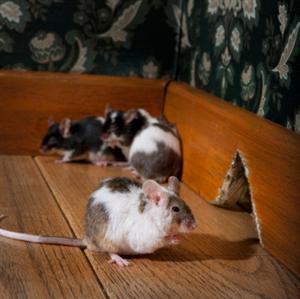| Complexity level: | 8 |
| Project cost ($): | 50 |
| Time required: | 1 day to prepare, 35 days for the science project experiment |
| Material availability: | Mice may be purchased at a pet store |
| Safety concerns: | Handle the mice carefully and was your hands after handling. |
Hypothesis
We hypothesize that the white mouse has the the dominant gene.
Overview
Laboratory mice
White mice were first bred and kept as pets in China and Japan around 1100 BC. They were preferred as pets because of their small size. They enjoy gentle handling and are fairly easy to rear as pets. A regular mouse is about 35 grams in weight and 17 cm in length from nose to tail. The average life-span of a mouse is about 2 years.
Mice can be kept and bred in simple cages. They will take about 3 months to grow into full adults. One male can be bred with as many as six female mice. Beyond this, the community gets a little too crowded and the mice may start turning on each other. Each mouse can give birth to between 4 and 11 babies at a time, after 18 to 21 days of pregnancy. The hair of young mice typically starts to grow after 3 days.
Mice can be bred to have coats of different colors like white, black, brown or blue, and their coats can be spotted or marbled. The color of their coats will be determined by 4 types of genes as follows:
- A - agouti , a – non-agouti
- B – black, b – brown
- C – color, c – albino
- D – non-dilute, d – dilute
Scientific Terms
Materials
The materials required for this science fair project:
- 2 male black mice (30-60 days of age)
- 2 male white mice (30-60 days of age)
- 6 female black mice (30-60 days of age)
- 6 female white mice (30-60 days of age)
- 4 cages or wooden boxes for the mice
- 1 bag of food
- newspaper
Procedure
1. For this science fair project, the independent variable is the color of the mice – black and white. The dependent variable is the color of the newborn mice. This is determined by observing the color of the fur on the newborn mice after 7 days. The constants (control variables) are the number of male and female mice in the cage, the size of the cage and the age of the mice.
2. Old newspapers are cut or torn into small pieces and placed on the floor of the boxes or cages. The mice are placed in the boxes according to the following colors :
a. Box 1 - 1 black male mouse and 3 white female mice
b. Box 2 - 1 black male mouse and 3 black female mice
c. Box 3 - 1 white male mouse and 3 white female mice
d. Box 4 - 1 white male mouse and 3 black female mice
3. The mice in the box will take about 1 week to breed and another 3 weeks for the gravidity (pregnancy). After about 4 weeks, the baby mice will be born. The number of newborn mice in each box is counted and recorded in the table given below.
4. It will take another 3 days for hair to start growing on the newborn mice, and this process will continue for about 10 days. Around the seventh to the tenth day, once the color of the hair is recognizable, record it in the table below.
Results
It was observed that white male and female mice produced only white colored baby mice. The participation of black color mice, either male or female, resulted in the birth of other mice of other colors, including black, brown, black-white and white mice.
| Parent | Total no. of newborn mice | No. of newborn mice in each box according to their color | ||||
| 1 Male | 3 Female | Black | Brown | Black-white | White | |
| Black | White | 21 | 10 | 3 | 0 | 8 |
| Black | Black | 24 | 13 | 4 | 3 | 4 |
| White | White | 22 | 0 | 0 | 0 | 22 |
| White | Black | 18 | 9 | 2 | 0 | 7 |
Conclusion
The hypothesis that the white mouse has the dominant gene, is proven to be false. The white mice couplesonly gave birth to white newborn. The dominant gene is in the black mice because they were able to produce litters of different colors, including black and white.
Mice have been kept and bred as pets for hundreds of years all over the world. They are available in various colors, are easy to handle and inexpensive to keep as pets. They also have a genome similar to humans. This is why mice have been used as laboratory animals to conduct experiments that cannot be done on humans.
Also consider
What would happen if the science fair project was repeated by breeding mice of different color coats?
The science fair project can also be done by breeding and comparing the eye color of the mice.
References
Laboratory mouse, white mouse - http://www.mouse-farm.eu/en/mice.php
Fancy mouse - http://en.wikipedia.org/wiki/Fancy_mouse
Genetic of the laboratory mouse - http://www.uac.arizona.edu/invest/rodentGenetics.pps#280,8,Mouse Coat Color Genetics

